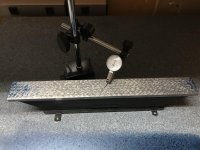I recently purchased the level from a local carpenter. From words of that guy, he bought the level brand new and used only a couple of times. Visual appearance confirms that - the thing looks like it's new, not a single scratch. However, when I checked it against a surface plate, the blue was only on very edges of the level. I measured the low spot with a dial indicator and it shows 0.001" hole in the middle, which seems like a lot to me. The surface plate was made and calibrated a few days ago, so I don't doubt it's accuracy. I also checked the level multiple times in different locations on the surface plate and results were identical.
The surface of the bottom of the level has very nice looking, consistent scraping marks. I believe they are original from the factory. I don't see any signs of excessive wear there, at least visually.
Is it supposed to be like that?
Thanks!
The surface of the bottom of the level has very nice looking, consistent scraping marks. I believe they are original from the factory. I don't see any signs of excessive wear there, at least visually.
Is it supposed to be like that?
Thanks!


